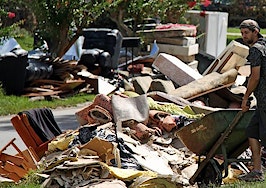- Overall distressed sales in May 2016 were down 2.1 percent year-over-year to 8.4 percent.
- Maryland had the highest share of distressed sales in May, with 19.4 percent of all sales.
- The largest year-over-year decline in distressed sales came from Florida where it dropped 5.5 percent to 15.8 percent.
At its peak in January 2009, distressed home sales — real estate owned (REO) and short sales — accounted for 32.4 percent of all sales in the U.S. That number dropped to 8.4 percent in May, with some states reporting even lower figures, according to CoreLogic.
Distressed sales decreased 2.1 percent year-over-year and one percentage point from the previous month, with only eight states recording higher figures from the year prior. According to Corelogic’s analysis, the pre-crisis distressed sales share teetered around 2 percent. The report shows if these same levels of decline continue, the housing market’s distressed sales will reach pre-crisis numbers in 2019.

Image courtesy Corelogic
Distressed sales by market
Maryland experienced the largest portion of distressed sales in May, CoreLogic says, at 19.4 percent. To that end, Baltimore’s distressed sales were nearly the same, with a 19.4 percent share of total sales. Distressed sales made up 7.6 percent of all sales in Washington D.C.
Connecticut and Michigan ranked second and third, with respective rates of 18.5 and 17.8 percent.
Illinois and Florida rounded out the top five states with the highest shares. Illinois’ distressed sales totaled 16 percent, with Florida close behind at 15.8 percent. Contributing to Illinois’ high amount was Chicago’s 18.1 percent market share of distressed sales. Of the total sales, 6.8 percent were REO sales and 4.6 percent were short sales.
Miami’s distressed market accounted for 13.9 percent of total sales. However, the Orlando metro area felt the sharpest year-over-year decline, falling 7.9 percent to a 16.4 percent share.
Distressed sales in Houston accounted for just 4.5 percent of all home sales in May. The state of Texas saw that share of the market decline 1.3 percent, to a 5.5 percent share.
Both Los Angeles and San Francisco continue to stay close to the pre-crisis national level. The L.A. metro experienced just 5.7 percent of sales as distressed in May, with the state of California slightly higher, at 6 percent. San Francisco, which continues to watch median home prices increase, had only 1.8 percent of its overall sales categorized as distressed.
Riverside. California, has experienced the most drastic change in distressed sales since the 76.5 percent peak in January 2009, CoreLogic says. In more than seven years since, Riverside’s distressed sales have dropped to 9.6 percent.
Although New York’s overall distressed sales share was 9.1 percent in May, the New York City metro area, which includes Jersey City and White Plains, jumped 0.1 percent year-over-year.













